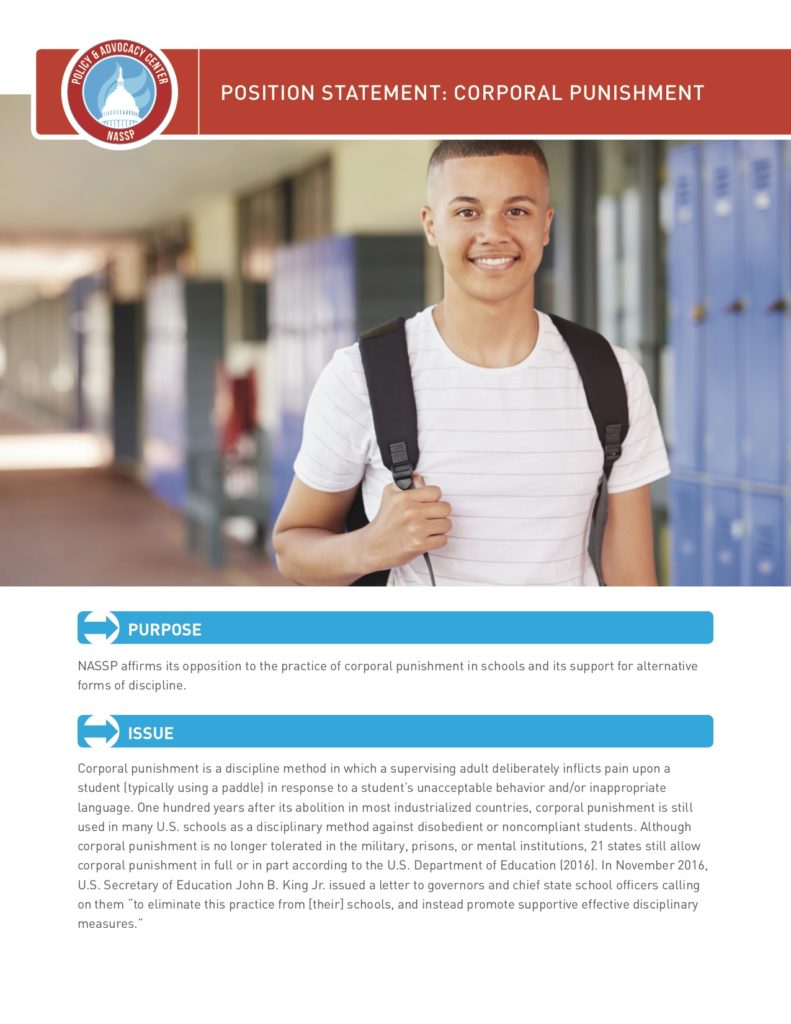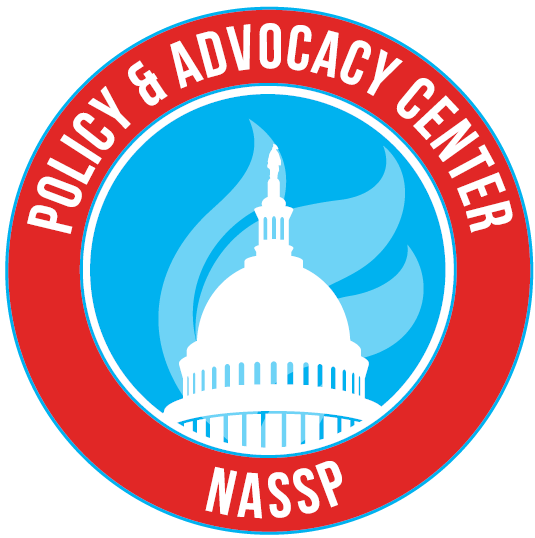NASSP affirms its opposition to the practice of corporal punishment in schools and its support for alternative forms of discipline.
Corporal punishment is a discipline method in which a supervising adult deliberately inflicts pain upon a student (typically using a paddle) in response to a student’s unacceptable behavior and/or inappropriate language. One hundred years after its abolition in most industrialized countries, corporal punishment is still used in many U.S. schools as a disciplinary method against disobedient or noncompliant students. Although corporal punishment is no longer tolerated in the military, prisons, or mental institutions, 21 states still allow corporal punishment in full or in part according to the U.S. Department of Education (2016). In November 2016, U.S. Secretary of Education John B. King Jr. issued a letter to governors and chief state school officers calling on them “to eliminate this practice from [their] schools, and instead promote supportive effective disciplinary measures.”
Every year, more than 110,000 students are subjected to this particular form of punishment in public schools, and a disproportionate number are minority students, male students, and students with disabilities. Corporal punishment is also legal in private schools in 48 states, but the U.S. Department of Education’s Office of Civil Rights does not collect discipline data from private schools. Of the public school population, 40,000—or more than one-third—of those students who were subjected to corporal punishment were black. However, black students represent only 16 percent of the total student population.
Research indicates that corporal punishment may adversely affect a student’s self-image and his or her school achievement (Society for Adolescent Medicine, 2003). Research has also shown a correlation between the use of corporal punishment and unintended negative consequences for children such as poor mental health, lower cognitive ability and academic achievement, and higher risk for physical abuse (Society for Research in Child Development, 2016). The practice of corporal punishment is inconsistent with legislative policies on child abuse and on racial, economic, and gender equity. Corporal punishment increases liability for school administrators and school boards. Educators and school boards are sometimes sued when corporal punishment is used in their schools.
Adopted May 7, 2004
Revised February 2009
Revised July 2018
Guiding Principles
- NASSP supports the federal goal of violence-free schools stated in Goals 2000: Educate America Act (1994). Every school in the United States should be free of drugs, violence, and the unauthorized presence of firearms and alcohol.
- The fundamental need of U.S. education is to find ways of engaging today’s students in the excitement of learning. Fear of pain or embarrassment has no place in that process.
- Students have the right to learn in a safe and secure environment. Schools have a responsibility to model for and teach our youth methods of exerting authority and modifying behavior that are constructive, humane, and provide opportunities for growth.
- NASSP first joined with the National Congress of Parents and Teachers, the National Education Association, the National Association of Elementary School Principals, the National Association of State Boards of Education, the American Medical Association, the American Academy of Pediatrics, the American Academy of Child and Adolescent Psychiatry, the National Association for the Advancement of Colored People, the American Bar Association, and many other groups calling for an end to corporal punishment.
- Many proven means of discipline promote self-control and the development of appropriate socially adaptive behaviors in constructive, unharmful ways.
- Discipline and corporal punishment are not synonymous.
- Discipline should be reasonable, timely, fair, age-appropriate, and an appropriate response to a student’s violation of the district code of conduct. The NASSP position statement on School Discipline (2015) encourages districts to focus on prevention and effective interventions as responses to disciplinary issues, including positive behavioral interventions and supports, social and emotional learning, peer juries, restorative justice processes, diversion, mentoring, mental health counseling, restitution, and community service programs.
Recommendations
Recommendations for Federal Policymakers
- Enact legislation that would prohibit the U.S. Department of Education from providing funding to any state or district that allows its school personnel to inflict corporal punishment, and that would award states and districts grants for improving school climate and culture.
- Fully fund the Student Support and Academic Enrichment grant program (Title IV, Part A of the Every Student Succeeds Act), whic schools can use to provide comprehensive mental and behavioral health services for students.
Recommendations for State Policymakers
- Enact legislation to prohibit the use of corporal punishment in schools.
- Provide funding to assist schools in recruiting and retaining school conselors, social workers, and psychologists to support school-based interventions and the coordination of services.
Recommendations for District Leaders
- Prohibit the use of corporal punishment as a form of discipline if it is still legally permitted in the state.
- Focus on prevention and effective interventions as responses to disciplinary issues, including positive behavioral interventions and supports, social and emotional learning, peer juries, restorative justice processes, diversion, mentoring, mental health counseling, restitution, and community service programs.
- Provide principals and teachers with ongoing, job-embedded professional development on child and adolescent development, culturally responsive classroom management, conflict resolution, restorative justice, and de-escalation approaches that decrease classroom disruptions and the need for disciplinary sanctions.
Recommendations for School Leaders
- Prohibit the use of corporal punishment as a form of discipline if it is still legally permitted in the state and district.
- Engage teachers and other school personnel in professional development programs to address the following alternatives:
- Help students achieve academic success through the identification of academic and behavioral deficiencies and strengths and help get them appropriate instruction.
- Adopt behavioral contracts among students, teachers, and parents.
- Encourage positive reinforcement of appropriate behavior.
- Use individual and group counseling.
- Encourage disciplinary consequences that are meaningful to students and have an instructional or reflective component such as restorative justice.
- Provide social skills training.
- Encourage programs that emphasize early diagnosis and intervention for school problems for both students and staff members.
- Encourage programs that emphasize values, citizenship, school pride, and personal responsibility and support the mental health needs of children.
- Encourage development of fair, reasonable, and consistent rules.
- Support strong parent/school and community/school communications and ties.
References
Society for Research in Child Development (2016). Corporal punishment in U.S. public schools: Prevalence, disparities in use, and status in state and federal policy. Retrieved from www.srcd.org/sites/default/files/documents/spr_30_1.pdf.
Goals 2000: Educate America Act, H.R. 1804 (1994). Retrieved from www.ed.gov/legislation/GOALS2000/TheAct/index.html.
National Association of Secondary School Principals (2015). School discipline. Retrieved from www.nassp.org/policy-advocacy-center/nassp-position-statements/school-discipline/.
Society for Adolescent Medicine, Ad Hoc Corporal Punishment Committee (2003). Corporal punishment in schools: Position paper of the Society for Adolescent Medicine. Journal of Adolescent Health, 32, 385–393.
Straus, M. A. (2000). Beating the devil out of them: Corporal punishment in American families and its effects on children. (2nd ed.). New Brunswick, NJ: Transaction.
U.S. Department of Education (2016). Civil Rights Data Collection for the 2013-14 School Year. Retrieved from www2.ed.gov/about/offices/list/ocr/docs/crdc-2013-14.html.
U.S. Department of Education (2016). King sends letter to states calling for an end to corporal punishment in schools. Retrieved from www2.ed.gov/policy/gen/guid/school-discipline/files/corporal-punishment-dcl-11-22-2016.pdf.


